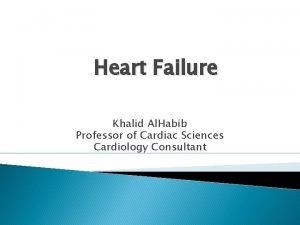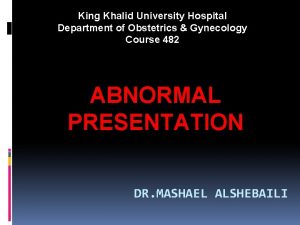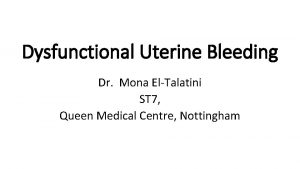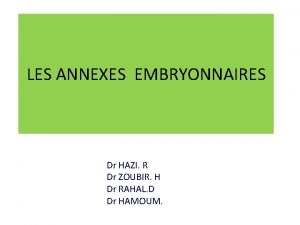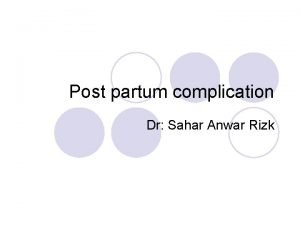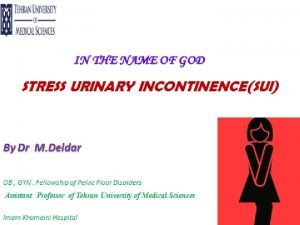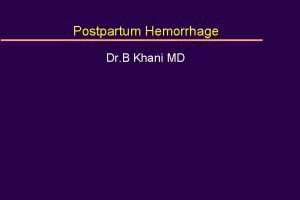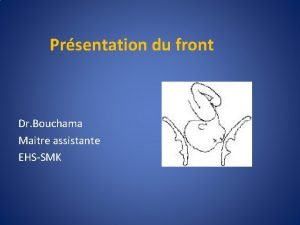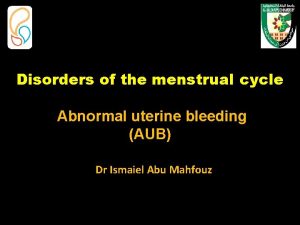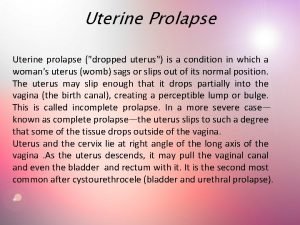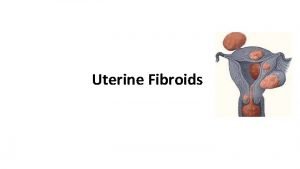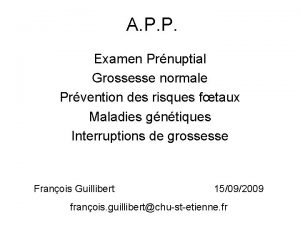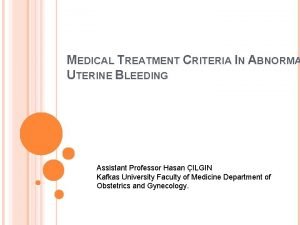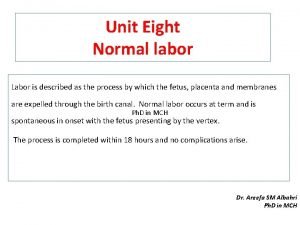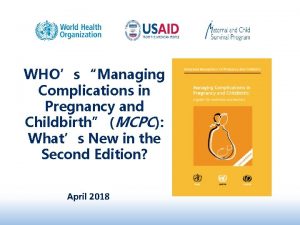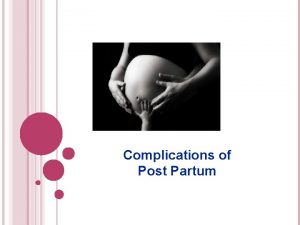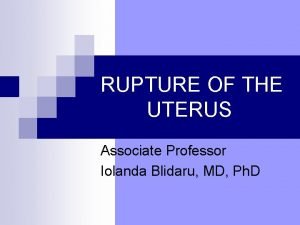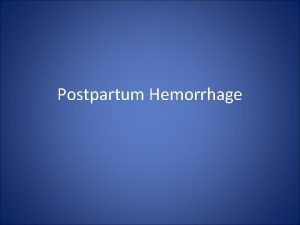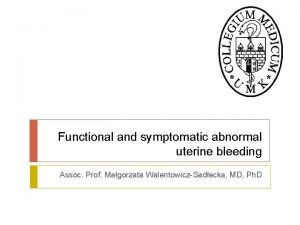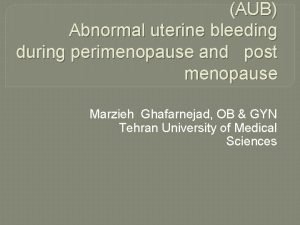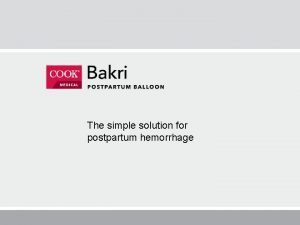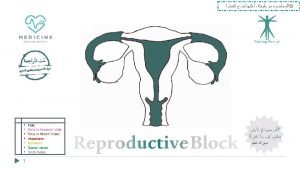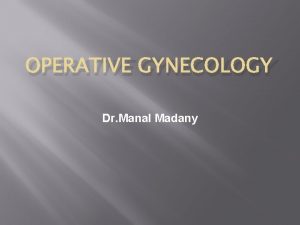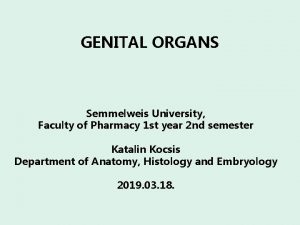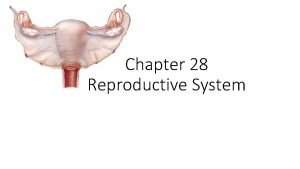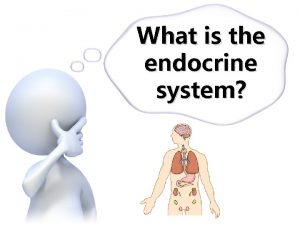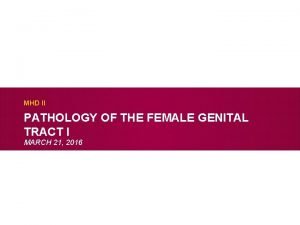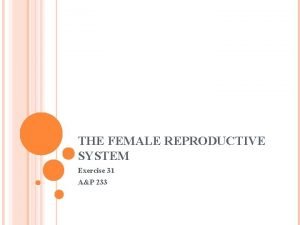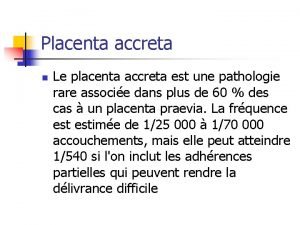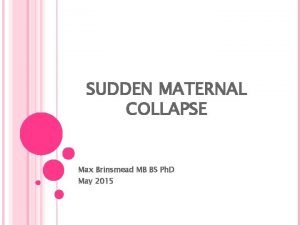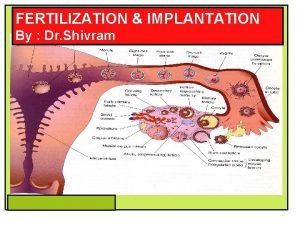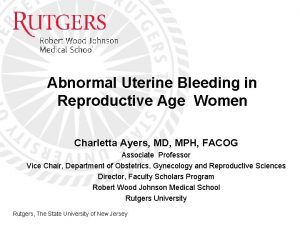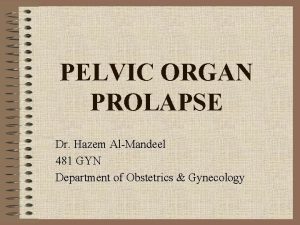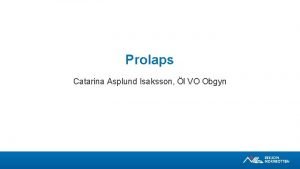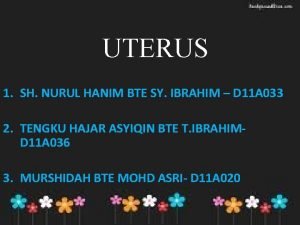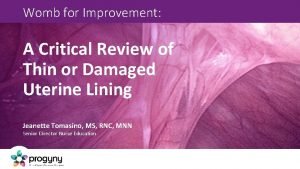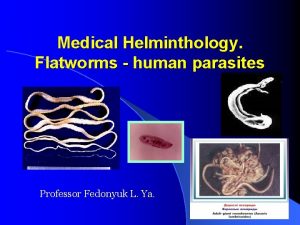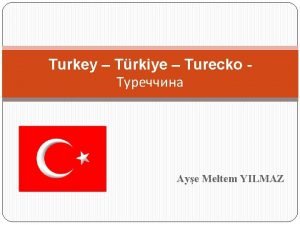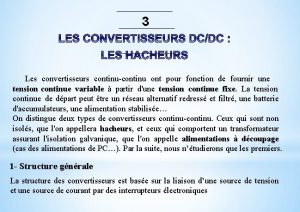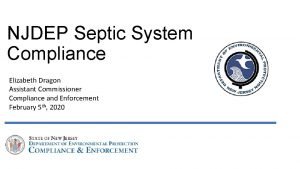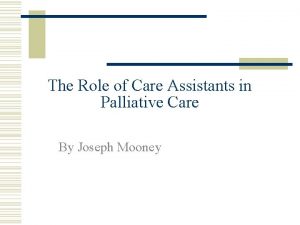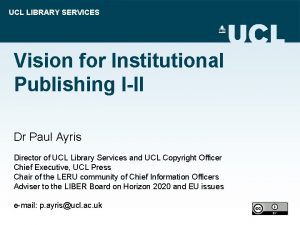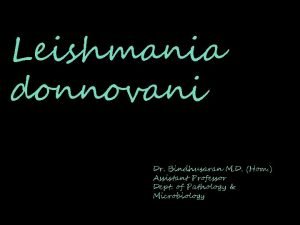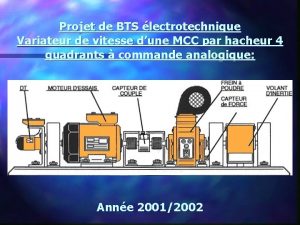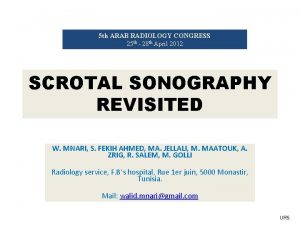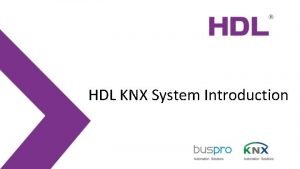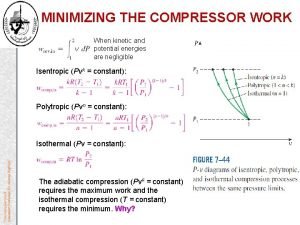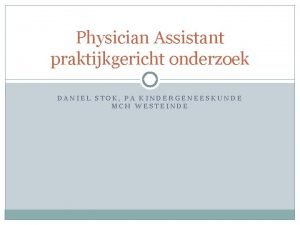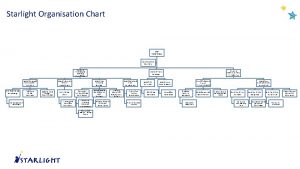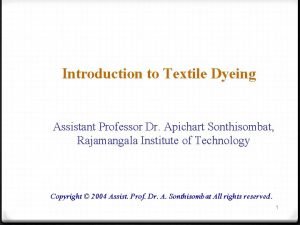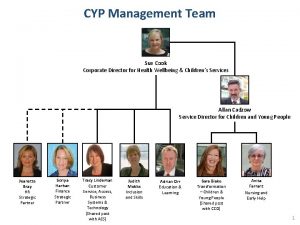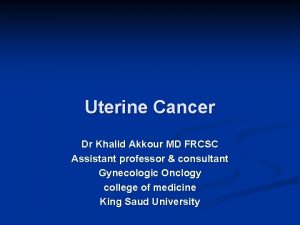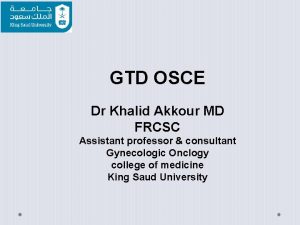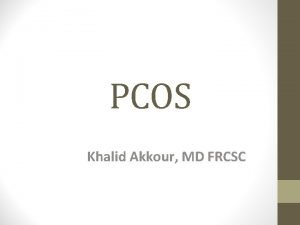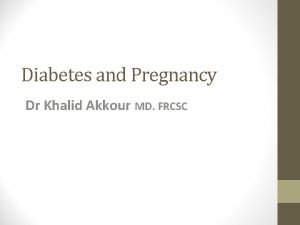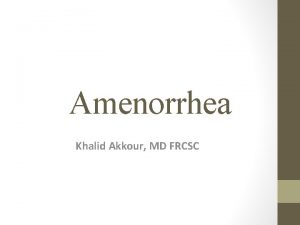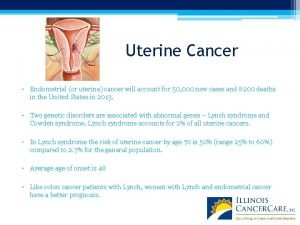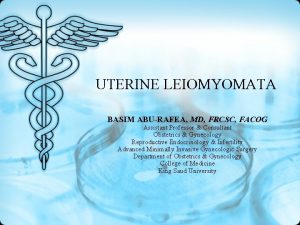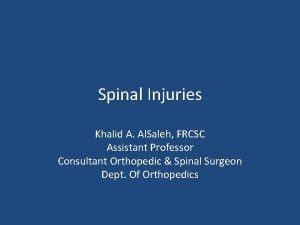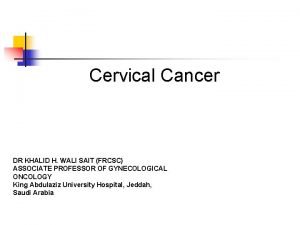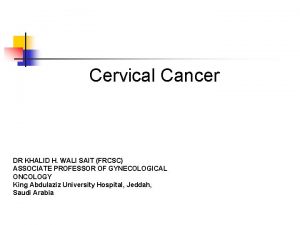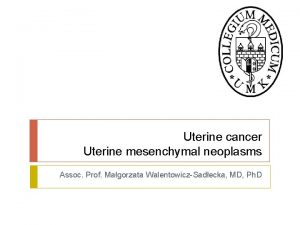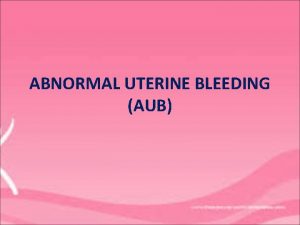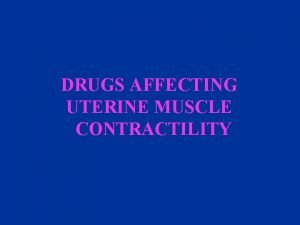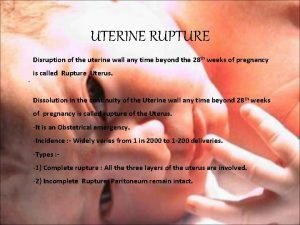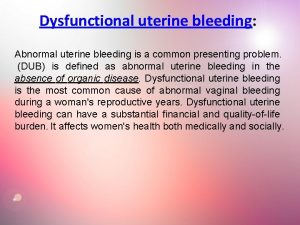Uterine Cancer Dr Khalid Akkour MD FRCSC Assistant


























































































































































- Slides: 154

Uterine Cancer Dr Khalid Akkour MD FRCSC Assistant Professor Gynecologic Oncology King Saud University Medical City

STRUCTURED OSCE ENDOMETRIAL CA 61 F with post-menopausal bleeding.

1. Take a focused history

Age Ethnicity HPI Timing Amount of bleeding – pad counts/hemorrhage/ER visits? Time since menopause Presence of vaginal discharge Use of HRT Other symptoms – weight loss, back pain, pelvic pressure, bloating, bowel/bladder complaints, leg swelling o Any previous work-up/investigations done o o o

Past Gyne Hx o. Age of menarche, menopause o. Cycles – regular? o. Use of OCP o. Pap smear o. Hx of: infertility, PCOS o. STI’s o. Gyne surgery

Past OBS Hx Past Medical Hx o o o Cancer – breast, colon Hypertension Diabetes Obesity Gallbladder disease Screening – mammogram/colonoscopy/BMD Past Surgical Hx Meds / treatments o o o Hormones (HRT, OCP, progestins) ASA NSAIDs Coumadin Previous pelvic radiation

Allergies Social Hx o Employment, profession Habits o Smoking o Et. OH o Drugs o Exercise Family Hx o Breast/ov/uterine/colon/prostate ca

2. Name 5 causes of postmenopausal bleeding

Vaginal atrophy Endometrial polyps Endometrial hyperplasia Endometrial CA Cervical CA Fibroids

3. What is the most common cause of postmenopausal bleeding?

Endometrial atrophy (60 -80%) Estrogen replacement therapy (15 -25%) Endometrial polyps (2 -12%) Endometrial hyperplasia (5 -10%) Endometrial cancer (10%)

4. What proportion of women with endometrial cancer are asymptomatic?


5. What percentage of women with PMB will have endometrial cancer?

10%

6. What proportion of women with endometrial cancer present with PMB?

66 % (2/3)

7. What is the lifetime risk of developing endometrial cancer


What % are diagnosed in pre menopausal women?

20 % (5% before the age of 40)

8. Why is the incidence of endometrial cancer raising?

Aging population Obesity epidemic

9. What are risk factors for endometrial cancer?

Age (older) RR: 2 -3 White race RR: 2 North America / Northern Europe RR: 3 -18 Higher level of education or income RR: 1. 5 -2 Obesity RR 3 (21 -50 lbs), RR 10 (> 50 lbs) PCOS RR > 5 Nulliparity RR 2 -3 Infertility RR: 2 -3 Late menopause RR 2. 4 Menstrual irregularities RR: 1. 5 Unopposed estrogen RR 4 -8 Tamoxifen RR 3 -7 Long-term use of high-dose menopausal estrogens Atypical endometrial hyperplasia (Risk 8%-29%) Diabetes RR 2. 8 HTN RR: 1. 3 -3 Gallbladder disease RR: 1. 3 -3 RR: 10 -20

Protective Long-term use OCP (RR: 0. 3 -0. 5) Cigarette smoking (RR: 0. 5) • Pregnancy Late Menarche (> 15 years of age) Pregnancy (Orlando course)

10. Why are obese people at increased risk of endometrial cancer?

Excess adipose tissue increases peripheral aromatization of androstenedione to estrone. Pre-menopausal women with increased estrone have abnormal feedback to HPA axis, resulting in oligo-anovulation, causing unopposed endometrial estrogen stimulation

11. What hereditary syndrome is associated with endometrial cancer?

HNPCC (Lynch syndrome) Lifetime risk of endometrial cancer 4060% Patients present with diagnosis about 10 years earlier • (ie: endometrial cancer in 50 s)- Orlando course

12. What would you perform on physical exam?

General : Obesity, pale / sick? Vitals : Hypertension HEENT : Supraclavicular nodes, evidence of anemia Resp : ? Lung metastases Breast : Masses, axillary lymphadenopathy Abd : Masses, ascites, liver enlargement, digital rectal exam Pelvic : Vulvar lesions, evidence of vaginal atrophy/lesions, cervical lesions, uterine size, adnexal masses, PV/PR : Posterior masses, parametrial thickness / masses, cul de sac nodularity PV : Leg swelling

13. Your patient is African-American, obese (BMI: 31), with mild HTN, taking no meds, but fatigued. What initial investigations would you order and WHY?

CBC (Hb, RDW, platlets) – anemia T & S Iron, Ferritan, TIBC, Transferrin (chronic anemia, iron stores) Tumor markers (CA-125, CEA) Pap smear EMB TVUS

What % of women with endometrial cancer will have an abnormal pap test? 30 -50% (Orlando course)

14. The TVUS shows normal uterine size, anteverted, with an endometrial thickness of 4 mm. What is the negative predictive value of this result? Would you do an EMB? Why?

q 99% if <6 mm (SOGC) q Type II endometrial cancers – not associated with hyperplasia

15. The biopsy samples get mixed up, the pathologist takes stress leave and you are presented with the following 5 results. Identify each smear.







A. Simple hyperplasia, no atypia (1% progression to ca) B. Complex hyperplasia, with ATYPIA (29%) C. Endometrial carcinoma (100%) D. Complex hyperplasia, no atypia (3%) E. Simple hyperplasia, with ATYPIA (8%)

16. What are the histological criteria for endometrial hyperplasia, with and without, atypia?

Hyperplasia is the proliferation of glands, characterized by irregular size and shape, increased gland-to-stroma ratio, but with no back-to-back or HINT: Atypia is cribiform glands best diagnosed with high power Simple hyperplasia magnification o. Glandular crowding o. Mild architectural complexity o. Virutally all glands are tubular. o. Occasional glands have inspissated secretions. o. The nuclei are basal.

Complex hyperplasia o o o Extensive glandular crowding Architextural complexity The cells lining this complex gland are pseudostratified. The nuclei are elongated and hyperchromatic. Nucleoli are not prominent. The cells retain in general their orientation to the lumen. No Atypia With Atypia o o Nuclear enlargement (elongated, hyperchromatic) Nucleoli are prominent Variation in nuclear size and shape Atypical mitosis TREATMENT OF ENDOMETRIAL HYPERPLASIA NO ATYPIA Low dose Progestins MPA 10 mg qd x 6 months High dose progestins MPA 200 qd Megestrol acetate 160 qd Micronized progesterone 200 qd Mirena WITH ATYPIA Hysterectomy & BSO High dose progestins Mirena EMB q 3 -6 MONTHS

Endometrial carcinoma o. Crowded glands, with little or no stroma o. Stromal inflammatory reaction surrounding endometrial gland o. Malignant nuclei (by HPF): round, course, chromatin clumping

17. Your patient is smear #4. What is your diagnosis? What is this patient’s risk of endometrial cancer?

COMPLEX HYPERPLASIA, WITHOUT ATYPIA (3 %)

18. What are your management options ?

Low dose Progestins (intermittent or continuous) o Post menopausal: Medroxyprogesterone Acetate (MPA) 10 mg po qd x 6 months o Mirena (Levonorgestrol) o In young, anovulatory women – CYCLIC • Medroxyprogesterone 10 mg / day x 10 days Diagnostic D & C / hysteroscopy o Improves tissue diagnosis o Improves symptoms Endometrial ablation Repeat EMB x 6 months Hysterectomy Weight loss

19. Whats the prevalence of endometrial cancer if the pathology had showed complex endometrial hyperplasia with atypia?

43%

20. What is the success rate of progestin therapy for non-atypical endometrial hyperplasia?

90%

21. 1 year later, your patient’s biopsy is repeated. With the same result (Smear 4 above). What is your management?

High dose progestins o. MPA 200 mg po qd o. Megestrol acetate 160 mg po qd (40 mg qid, 80 BID) o. Micronized progesterone 200 mg po qd o. Mirena o. Depot provera 150 q 12 weeks (orlando course) Repeat EMB (3 -6 months) Hysterectomy

22. 6 months later, your patient’s biopsy result is Slide 2 above. What is the diagnosis? What is the risk of progression to endometrial carcinoma? What % of these biopsies are actually positive for cancer?

SLIDE 2: complex hyperplasia, with atypia 29% 40 -50%

23. What is your management?

Hysterectomy Poor surgical candidates or fertility preservation o Continuous High dose progestin therapy MPA 200 mg po qd Megestrol acetate 160 mg po qd (40 mg qid) Micronized progesterone 200 md po qd EMB q 3 months

24. What is the diagnostic accuracy of endometrial biopsy?

q 93 -98%

25. Your patient requested hormonal therapy, for personal reasons. She returns 9 months later, with a biopsy result – SLIDE 3 above. What is her diagnosis? Management?

Endometrial carcinoma Management: Gyne-Onc consultation Surgical staging TAHBSO Peritoneal washings – but it doesn’t change the staging anymore PLND Frozen section

26. What are the indications for surgical staging in endometrial CA?

Histology: Grade > 1 (includes serous, clear cell etc) Myometrial invasion > 50% Cervical extension Extrauterine spread Enlarged lymph nodes • (Orlando course)

27. List 5 histological types of primary endometrial adenocarcinoma.

Endometroid adenocarcinoma o o With squamous differentiation (elements) Villoglandular variant Secretory variant Ciliated variant Clear cell Papillary Serous Mucinous Squamous Mixed Undifferentiated

28. Distinguish the 2 categories of endometrial adenocarcinoma.

TYPE 1: 75% Endometroid Estrogen dependent (PCOS, DM, obesity) Premenopausal (25%) & Post-menopausal (75%) women White U/S: Endometrial hyperplasia Low grade Minimal myometrial invasion Stable tumors

TYPE 2: 25% Papillary serous, clear cell Non-estrogen dependent / less likely Post-menopausal No endometrial hyperplasia Black Grade 3 Deep myometrial invasion Aggressive

29. List the prognostic factors for endometrial cancer

Age (> 60, worst prognosis) Histological type (poor = pap serous or clear cell) Histological / nuclear grade (G 3 worst prognosis) Vascular space invasion Myometrial invasion Tumor size Peritoneal cytology Lymph node metastasis Adnexal metastasis High expression levels of ER + PR = POOR

30. How are Type 1 and Type 2 endometrial cancers spread?

• Type 1 : order of spreading Direct extension Lymphatic metastasis Hematogenous Intraperitoneal • Type 2: simultaneous

31. What is the pattern of lymphatic spread of endometrial cancer?

32. What are the histological risk factors for lymph node metastasis in endometrial cancer?

Tumor Stage Depth of myometrial invasion Histological / nuclear Grade Degree of tumor differentiation Histological Type

33. What is the chance that a Grade 3 endometrial carcinoma, with > 50% invasion of the myometrium will have positive pelvic and paraaortic lymph nodes

Pelvic LN – 37% Peri-aortic LN – 13% Table 33 -7 Correlation of Histologic Grade and Depth of Myometrial Invasion with Risk of Nodal Metastases Pelvic Lymph Nodes Myometrial Para-aortic Lymph Nodes G 1 G 2 G 3 None 1% 7% 16% <1% 2% 5% 50% 2% 6% 10% <1% 2% 4% >50% 11% 21% 37% 2% 6% 13% Invasion

33. For what type of tumor is surgical staging not required? Why?

Endometriod, Grade 1, superficial myometrial invasion Chance of LN metastasis low (Pelvic: 1%, Peri-aortic: <1%)

35. What are the histopathological criteria for assessing tumor GRADE?

Grade 1: < 5% nonsquamous or non-morular solid growth pattern Grade 2: 6 -50% nonsquamous or non-morular solid growth pattern Grade 3: > 50% nonsquamous or non-morular solid growth pattern

36. What is the best management of your patient at this point?

STAGING SURGERY: TAHBSO, peritoneal washings, pelvic and para-aortic lymphadenectomy, If serous or clear cell features on pre-op biopsy: infracolic omentectomy, and biopsies of peritoneum, pericolic gutter, diaphragm.

37. What is the best surgical approach? List 3 advantages & disadvantages of MIS.

SURGICAL APPROACH o Laparoscopic TAH & lymphadenectomy o Laparoscopic-assisted robotic TAH / lymphadenectomy o Laparotomy Advantages of Laparoscopic staging surgery o Obese population o Decreased blood loss o Fewer blood transfusions o Lower perioperative morbidity o Faster recovery time o Shorter hospital stay o Decreased post-operative pain o Fewer would infections o Less loss of income o Improved quality of life o Similar survival rates Disadvantages of laparoscopy o Surgeon-skill dependent o Prolonged surgical time o Equipment o Conversion to laparotomy is a risk o Incomplete staging – is a risk o Complications (damage to adjacent structures-ureter, bladder)

38. You obtain informed CONSENT for your patient. What will you tell her?

Diagnosis Description of suggested treatment Explanation of what the treatment will do / mechanism Prognosis with the treatment Side effects of treatment Adverse events associated with this treatment Therapeutic alternatives: including their benefits, side effects, prognosis Prognosis – with no therapy

39. The patient is booked for surgery, cancelled twice due to lack of surgical beds and 8 months later receives a TAHBSO, washings + LND (pelvic & perioaortic). RESULTS:

SLIDE A

SLIDE B

q. Slide A: Identify the type, grade, incidence & prognosis:

o Papillary serous carcinoma of the endometrium (Type II) o Grade 3 o Incidence: 5 -10% of endometrial carcinomas

Slide B: Identify. What % of these tumors will have this finding? List 3 tumors where these structures are found.

o Psammoma bodies: A psammoma body is a round collection of calcium, seen microscopically. o 30% of UPSC (uterine papillary serous carcinoma) – because histologically they resemble epithelial ovarian cancer o TUMORS with psammoma bodies: Endometrial PAP-SEROUS Ovarian PAP-serous Thyroid papillary CA Renal papillary CA Breast pancreas

Pathology report: Tumor invasion to the left parametrium, with 6 + iliac lymph nodes. What is her stage? How will you treat her?

o. STAGE III C 1 o. Adjuvant Chemotherapy +/or tumordirected external beam radiotherapy

40. Your keen junior resident asks you to summarize the latest FIGO staging for endometrial cancer and the management.

STAGE 1 A “ CRITERIA CONFINED TO UTERUS < 50 % myometrial invasion “ > 50% myometrial invasion 1 B NCCN 2011 Guidelines – Treatment of Endometrial CA (COMPLETELY SURGICALLY STAGED) ADVERSE FACTOR Adjuvant Therpay G 1 G 2 NEG Observe or vaginal brachytherapy POS Observe or vaginal brachytherapy and/ or pelvic RT NEG Observe or vaginal brachytherapy “ “ POS Observe or vaginal brachytherapy and/ or pelvic RT POS II Tumor invades cervical stroma, but does not extend beyond the uterus Vaginal brachytherapy and /or pelvic RT IIIA Tumor invades serosa and/or adnexae POS IIIB Vaginal and/or parametrial involvement Metastasis to pelvic and/or paraortic lymph noes Pelvic Para-aortic Distant metastasis, or invasion of bladder or bowel mucosa POS -Chemotherapy +/- RT -Tumor directed RT +/chemotherapy -Pelvic RT +/- vaginal brachytherapy CHEMOTHERAPY +/TUMOR-DIRECTED RT IIIC 1 IIIC 2 IV Observe or vaginal brachytherapy and /or pelvic RT Pelvic RT and vaginal brachytherapy -Chemotherapy +/- RT -Tumor directed RT +/chemotherapy -Pelvic RT +/- vaginal brachytherapy POS POS CHEMOTHERAPY +/TUMOR-DIRECTED POST-OP EXTERNAL BEAM RT Adjuvant Therpay G 3 Observe or vaginal brachytherapy and/ or pelvic RT Observe or vaginal brachytherapy and /or pelvic RT Observe or pelvic RT and/or vaginal brachytherapy, +/chemotherapy Pelvic RT and vaginal brachytherapy +/chemotherapy -Chemotherapy +/- RT -Tumor directed RT +/chemotherapy -Pelvic RT +/- vaginal brachytherapy

*ADVERSE RISK FACTORS: Age, positive lymphovascular invasion, tumor size, lower uterine segment involvement (cervical/ glandular)

41. What is 1 st line chemotherapy in the treatment of uterine adenocarcinoma?

Cisplatinum & Doxorubicin (adriamycin) Cisplatinum, Doxorubicin, Paclitaxel (TAPsuperior to above) Carboplatinum & Paclitaxel

CHEMOTHERAPY – ENDOMETRIAL CARCINOMA CLASS Drug Mechanism of action Indication Cisplatinum Platinum complexes bind DNA, causes interference with DNA processing & replication -Blocks DNA throughout cell cycle Carboplatinum “ Ovarian, tubal, peritoneal, Ototoxicity endometrial, cervical and Severe peripheral vulvar cancers neuropathy Electrlytes: Hypo-Mg Hypo-K Seizures Nausea/V “ NOT nephrotoxic Nausea/V Alopecia rash Paclitaxol Taxotere Inhibits MITOSIS – blocks spindle formation by promoting microtubule assembly. Inhibits depolymerization of tubulin during mitosis. Arrests cell division in the M phase. Streptomyces peucetius -binds DNA -G 1 and S phases -inhibits topoisomerase II in G 2, blocks supercoiling of DNA Ovarian CA, cervical, endometrial, sarcomas Hypotension Sensory & peripheral neuropathy, Bowel performation Ovarian Ca, Endometrial, Cervical Alpecia Congestive heart failure, Skin toxicity: Cardiomyopathy Necrosis, soft tissue ulceration, palmar plantar dysesthesia Facilitates transfer of alkyl groups to DNA -blocks G 1 -S Blocks N 7 position of guanine, causing cross link bridges in DNA Rarely used as primary treatment in gyne malignancies Hemorrhagic cystitis, Leukopenia Alopecia, amenorrhea, nausea/V, PLATINUMBASED PLANT ALKYLOIDS YEW tree ANTI-TUMOR ANTIBIOTICS Doxorubicin (Adriamycin) - Side Effects Potentially Lethal Effects Nephrotoxic Mylosuppresion Leukopenia Thrombocytopenia Anemia Hepatotoxicity Hypersensitivity Neutropenia Bradycardia & cardiomyopathy (rare) ALKALATING AGENTS Cyclo - phosphamide Ifosfamide Mylosuppression (bone marrow) Renal failure Thrombocytopenia Leukemia NCCN Feb-2011

42. What is the prognosis (by stage) in endometrial cancer?

STAGE I (A/B): STAGE III STAGE IV : : : 91% 70% 50% 10 -20%

43. How would you treat a grade 3 adenocarcinoma of the uterus?

Treatment is INDIVIDUALIZED Comprehensive surgical staging should be done, including o. TAHBSO, Washings o. Lymphadenectomy: pelvic, perioartic o. Infracolic omentectomy o. Peritoneal biopsies: pelvic side wall, pericolic gutter diaphragm o. Optimal debulking Adjuvant treatment (chemotherapy, brachytherapy,

44. AFTER STAGING SURGERY, for which tumor stage / grade is OBSERVATION appropriate? (updated from SOGC)

Stage IA (no/minimal myometrial invasion), G 1/G 2 Stage IB (< 50% (minimal) myometrial invasion), G 1/2 Adjuvant treatment ○Stage IB grade 1, 2 or Stage 1 A grade 3 endometrial adenoca (intermed. risk) ○Stage II decided on an individual basis ○Stage III and IV endometrial cancer individualize – chemo/radio or both

45. For which tumor stage / grade is RADICAL HYSTERECTOMY appropriate?

q Stage II (Tumor invades cervical stroma)

46. Why do we bother taking peritoneal washings?

Positive peritoneal washings are poor prognostic factor (adverse condition) Washings are no longer part of FIGO staging

46. What would be the stage of a tumor involving > 50% of the myometrium, with endocervical gland involvement? What surgery should done?

Stage 1 b (endocervical glands are no longer stage II) TAHBSO + staging – not radical hyst

48. Your patient recovers from surgery, receives 6 cycles of adjuvant carbotaxol with minimal complication and returns to her usual life activities. How will you follow her up?

5 year follow-up YEARS 1 & 2: o Pt counselling: re symptoms o Physical exam q 3 -6 months x 2 years o PAP q 6 months x 2 years (not supported by data) o Annual CXR o Annual CA-125 (optional) o CT-abdomen & pelvis: as clinically indicated o Genetic counselling (if strong family hx – ie. Lynch) • YEARS 3, 4, 5 o Physical exam q 6 months or annually o PAP – annually? o CXR - Annually ? o CA-125? o CT-abdomen & pelvis: as clinically indicated

49. What % of patients will have recurrent endometrial cancer more than 5 years after initial diagnosis? To which organs?

q 10% q Metastasis in recurrent endometrial CA o. Pelvis & vagina (50%) o. Lung (17%) o. Upper abdomen (10%) o. Bone (6%) Source: Aalders et al

50. Your patient has a disease-freeinterval of 3 years, but returns to you with a new vaginal lesion. . What treatment options are available for recurrent endometrial CA?

Radiation: for local recurrences (vaginal mucosa) Surgery: for resectable nodules Hormonal treatments: studies showed improved survival rates Chemotherapy

51. List the hormonal treatment options are available for advanced or recurrent endometrial cancer

• • • Progestins (high dose) Aromatase inhibitors Tamoxifen

CASE 2 – Fertility Preservation in Endometrial CA

A 34 woman, with an EMB showing Grade 1 Adenocarcinoma of the endometrium, endometroid type, wants to preserve her fertility. What is your management? .

Referal to gyne onc Radiographic imaging (CT abdomen & pelvis, or MRI pelvis) Indications for fertility sparing management: WG i. Grade 1 endometroid (Type 1) tumors, Grade 2 (rarely) ii. No evidence myometrial invasion (by radiography) iii. Diagnostic Laparoscopic (for Grade 2) – must be negative Hormonal therapy i. Megestrol acetate 160 mg po qd ii. MPA 200 mg po / im qd iii. Progestins + Tamoxifen + Gn. RH agonists (less frequently used) Informed consent i. Risks of disease progression ii. If treatment successful, risk of relapse is high iii. Risk of infertility iv. Risk of needing curative surgery anyhow Long Term Observation i. Repeated EMB or D & C – q 3 months ii. If lesion does not regress – hysterectomy Infertility – increased incidence. Refer to fertility center.

CASE 3 – INCOMPLETE STAGING (Endometrial CA)

You do a TAH + BSO on a 48 year woman for menorragia. The pathology comes back Grade 3 endometroid adenocarcinoma of ovary, 75% myometrial invasion, confined to the uterus. Q 1: How will you manage this pt? What are HER management

MANAGEMENT – as a general gynecologist Counsel the patient Refer to Gynecology-oncology Arrange initial investigations: o o o Physical exam: lymphadenopathy CXR Tumor Markers Labs: CBC, electrolytes CT-abdomen & pelvis (lymphadenopathy) • MANAGEMENT OPTIONS for this patient Do nothing – expectant management (not recommended – G 3) Radiographic imaging (CT abdomen & pelvis) o If positive findings - SURGICALLY RESTAGE a. Laparoscopic Lymphadendectomy b. Laparotomy o If negative radiographic evidence, refer to radiation oncology: a. Pelvic radiotherapy or b. Vaginal brachytherapy, + Surgically restage (regardless of imaging) +/- Chemotherapy (for Grade 3 tumors)

Q 2. What will you tell your patient?

Patient communication Explain the results of the surgery – intraoperative Explain the pathology findings – she has cancer Educate pt regarding cancer staging and grading & importance for treatment Inform pt: incomplete surgical staging Explain her preliminary diagnosis (stage, grade) – she will ask At least stage IB, Grade 3, but we cannot comment on prognosis because further work-up is warrented Do NOT discuss prognosis to the patient – b/c we don’t know Emphasize aggressive tumor grade, the high risk of LN metastasis, the improvement of outcome with proper staging - she needs surgery Explain – she will be referred to gynecology oncology

Q 3. What increases the risk of LN metastasis in endometrial cancer?

The risk of LN metastasis increases with: Stage Depth of invasion Grade

Q 4. What is the approximate risk of LN invasion (pelvic and periaortic)?

Table 32 -7 -- FIGO Staging and Nodal Metastasis METASTASIS Staging Pelvic Aortic IA G 1 (n = 101) 2 (2%) 0 (0%) G 2 (n = 169) 13 (8%) 6 (4%) G 3 (n = 76) 8 (11%) 5 (7%) IB G 1 (n = 79) 3 (4%) From Creasman et(10%) al: Surgical pathologic spread patterns G 2 (n = 119) WT, Morrow CP, Bundy BN, 12 8 (7%) of endometrial cancer. Cancer 60: 2035, 1987. Reprinted with permission. G 3 (n = 77) 20 (26%) q Based on current information, the patient has AT LEAST G 3, Stage 1 b q Risk of pelvic lymph node metastasis: 26% q Risk of peri-aortic LN metastasis: 16% 12 (16%)

Q 4. Your patient is reluctant to undergo another surgery after what she’s been through. How do you counsel her?

Explain theoretical risks of lymph node metastasis and encourage her to; see the gynecology-oncology specialists Receive a proper staging surgery Sources: NCCN 2011, Comprehensive (5 th): pg. 824

LEIOMYOSARCOMA

Introduction • ULMS incidence is 0. 7 -1. 0/100, 000 • Most ULMS are high grade sarcomas with high risk of recurrence & progression. • Overall survival is dependant on the stage , 5 y survival for - stage 1 = 76% , stage 2 = 60%, stage 3 = 45% stage 4 = 29%. • Metastatic disease usually in the 5 th decade or before in a women with a good performance status. • Response rate for chemotherapy in the metastatic setting is reported to bé 15 -54%.

Diagnosis • Some small studies showed that MRI can distinguish benign from malignant lesions • Intrauterine tumors increasing in size after menopause should rise the suspecion for malignancy. • In most patients, the diagnosis of LMS is made at the time of myomectomy or hysterectomy for persumed benign disease.

Staging - FIGO 2009

Initial Treatment • Surgery : Øfor patients whose disease is limited to the uterus, hysterectomy is recommended. Øif malignancy is suspected preoperatively , no mocellation US-FDA issued a safety alert 2014 against power morcellators. Øroutine LN dissection is not recommended , only large or suspecious nodes have to bé removed. ØBSO is reasonable in perimenopausal & postmenopausal women. No survival benefits. Ø 40 -70% of ULMS are ER &/or PR positive ØPATIENTS < 50 Y with disease limited to uterus , no difference whether BSO is done or not.

Initial Treatment • If the disease is locally advanced but potentially completely resectable, an attempt to resect it is reasonable, optimal cytoreduction increased both PFS & OS. • For multisite metastasis or unresectable disease >> no role for hysterectomy ( only palliative e. g severe uterine bleeding ) • Laparoscopic re-evaluation after morecellation hysterectomy should bé considered to evaluate for & resect any residual disease. • Resection of the cervix & doing BSO if not yet done is reasonable for those had only supracervical hysterectomy.

Post-resection management of uterus-limited disease • Although the risk of recurrent disease is >50%, no adjuvant intervention has been shown to improve PFS or OS. • The standard management is observation. • 30% of patients found to have ULMS at the time of surgery will have metastatic disease. • CT , PET/CT or MRI is recommended postoperatively to r/o distant mets. • Adjuvant radiation did not show any survival benefit (local recurrence was the same for the radiation & the control group).

Post-resection management of uterus-limited disease • Adjuvant chemotherapy with doxyrubicin did not show a survival benefit. • Adjuvant docetaxel + Gemcitabine followed by doxyrubicin improved 2 y PFS to 78% but failed to improve OS. • An International randomized phase III trial of observation versus Gemcitabine/docetaxel for 4 cycles followed by doxyrubicine 4 cycles is ongoing - GOG 277)

Post-resection management of locally advanced disease • No consensus • Observation, Chemo , radiation or hormone blockade therapy are acceptable options.

Metastatic disease • If complete resection of the metastatic disease is possible >> survival benefit. • No consensus for the adjuvant treatment

Systemic treatment options for unresectable or metastatic disease • No established superior 1 st line chemotherapy. • Reasonable regimens to consider : - doxyrubicin , 19% RR - doxyrubicin/ifosfamide 30% RR - gemcitabine 20% RR - gemcitabine/docetaxel 27% RR - ifosfamide 17% RR • Other chmotherapeutic agents used as 2 nd line are : pazopanib 6% RR, trabectudine 10 -16% , decarbazine or temzolomide. • Hormonal therapy such as aromatase inhibitors should bé considered when hormone receptors are positive >>10% survival benefit in a small burden/indolent disease.

Thank You
 Nationality vs citizenship
Nationality vs citizenship Khalid al habib
Khalid al habib Khalid bazaid
Khalid bazaid Your name is ali khalid, isn't it
Your name is ali khalid, isn't it Welcome to english class images
Welcome to english class images Dr khalid jamal
Dr khalid jamal Khalid farhan course google drive
Khalid farhan course google drive Nauman khalid md
Nauman khalid md Khalid al dossary
Khalid al dossary Arzoo khalid
Arzoo khalid Samra khalid
Samra khalid 911 in roman
911 in roman Khalid alsadhan
Khalid alsadhan Brow presentation birth
Brow presentation birth Fariza khalid
Fariza khalid Dr sana khalid
Dr sana khalid Cherki karkaba
Cherki karkaba Khalid mustafa
Khalid mustafa Fariza meaning
Fariza meaning Dr khalid waheed
Dr khalid waheed Khalid bakri
Khalid bakri Khalid karaoui
Khalid karaoui Cipralex side effects
Cipralex side effects Archaeplastida
Archaeplastida Abnormal uterine bleeding pathophysiology diagram
Abnormal uterine bleeding pathophysiology diagram 4eme semaine
4eme semaine Sahar anwar
Sahar anwar Bulbocavernosus reflex
Bulbocavernosus reflex Uterine atony
Uterine atony Efface
Efface Syncipito définition
Syncipito définition Abnormal uterine bleeding in postmenopausal
Abnormal uterine bleeding in postmenopausal Uterus displacement
Uterus displacement Bonney hood incision
Bonney hood incision Tphandrl
Tphandrl Status anxiety
Status anxiety Abnormal uterine bleeding definition figo
Abnormal uterine bleeding definition figo Chorion
Chorion Uterus reaches the level of umbilicus at
Uterus reaches the level of umbilicus at Uterine prolapse treatment non surgical
Uterine prolapse treatment non surgical Uterine compression sutures
Uterine compression sutures Womens anatomy diagram
Womens anatomy diagram Uterine atony
Uterine atony Stage of development
Stage of development Uterine irritability
Uterine irritability Dr blidaru iolanda
Dr blidaru iolanda Bimanual compression
Bimanual compression Małgorzata walentowicz-sadłecka
Małgorzata walentowicz-sadłecka Endometrial thickness post menopausal
Endometrial thickness post menopausal B lynch
B lynch Cows scoring
Cows scoring Phases of uterine cycle
Phases of uterine cycle Ferguson reflex definition
Ferguson reflex definition Modified shirodkar cerclage
Modified shirodkar cerclage True labor signs
True labor signs Uterine cavity
Uterine cavity Uterine volume by age
Uterine volume by age Uterine balloon tamponade
Uterine balloon tamponade Abnormal uterine bleeding
Abnormal uterine bleeding Uterine irritability
Uterine irritability Anteflexion of uterus
Anteflexion of uterus Similarities between female and male reproductive system
Similarities between female and male reproductive system Types of style
Types of style Narrowest part of uterine tube
Narrowest part of uterine tube Serosa of fallopian tube
Serosa of fallopian tube Thickening of uterine lining
Thickening of uterine lining Matthew duncan placental separation
Matthew duncan placental separation Cardinal ligament
Cardinal ligament Describe the picture
Describe the picture Uterus seal
Uterus seal Uterine tube
Uterine tube Nahida chakhtoura
Nahida chakhtoura Uterotonics
Uterotonics Synéchie utérine traitement naturel
Synéchie utérine traitement naturel Uterine inversion
Uterine inversion Uterus stimulant drugs
Uterus stimulant drugs Uterine cavity
Uterine cavity Vaginal bleeding
Vaginal bleeding Types of uterine prolapse
Types of uterine prolapse Hauteur utérine
Hauteur utérine Slyngplastik
Slyngplastik Ampulla uterus
Ampulla uterus Uterine cavity
Uterine cavity Cystocele with incomplete uterine prolapse
Cystocele with incomplete uterine prolapse Biohelminthes
Biohelminthes Cisco attendant console standard
Cisco attendant console standard Executive assistant conference 2019
Executive assistant conference 2019 Assistant computer control
Assistant computer control Role of a teaching assistant
Role of a teaching assistant Assistant
Assistant Assistant director vicky
Assistant director vicky Ethical and legal issues affecting the nursing assistant
Ethical and legal issues affecting the nursing assistant What are the duties of assistant scorer?
What are the duties of assistant scorer? Hud assistant secretary
Hud assistant secretary Kpu health care assistant
Kpu health care assistant Qcm validation formation assistant maternel
Qcm validation formation assistant maternel Pulse sites
Pulse sites Comenius assistant
Comenius assistant Dental charting tooth surfaces
Dental charting tooth surfaces Hacheur assistant
Hacheur assistant Personal writing assistant
Personal writing assistant Assistant teacher of gps
Assistant teacher of gps Head girl manifesto for primary school
Head girl manifesto for primary school Medicare assistant
Medicare assistant Bakersfield adults school
Bakersfield adults school Vms4200
Vms4200 Veternary
Veternary The assistant chapter 24
The assistant chapter 24 Promotion from assistant to associate professor
Promotion from assistant to associate professor When did you last go
When did you last go What credential is issued by the danb
What credential is issued by the danb Akshay kumar assistant
Akshay kumar assistant Assistant secretary for aging
Assistant secretary for aging Njdep compliance and enforcement
Njdep compliance and enforcement Palliative care assistant
Palliative care assistant Office management assistant psc
Office management assistant psc Adminastrative assistant day
Adminastrative assistant day Ucl library assistant
Ucl library assistant Assistant district commissioner scouts
Assistant district commissioner scouts Junior assistant scoutmaster
Junior assistant scoutmaster Assistant
Assistant The circulating assistant is usually not responsible for
The circulating assistant is usually not responsible for Virtually there e ticket receipt
Virtually there e ticket receipt At a clothes shop
At a clothes shop Leishmanioma
Leishmanioma Medical assistant lesson plan
Medical assistant lesson plan The nursing assistant and the care team chapter 2
The nursing assistant and the care team chapter 2 Patient safety assistant
Patient safety assistant Hacheur assistant
Hacheur assistant The signmaker's assistant main idea
The signmaker's assistant main idea Bakersfield adults school medical assistant
Bakersfield adults school medical assistant Varicocele grading radiology assistant
Varicocele grading radiology assistant Hdl knx
Hdl knx Isentropic efficiency of a compressor
Isentropic efficiency of a compressor Mia irwan
Mia irwan Daniel stok
Daniel stok Fujitsu alexa
Fujitsu alexa Arbitre assistant robot
Arbitre assistant robot Danfoss link home assistant
Danfoss link home assistant Mon assistant visuel sncf
Mon assistant visuel sncf Assistant principal portfolio
Assistant principal portfolio Dual career path
Dual career path Attribute assistant arcmap
Attribute assistant arcmap Starlight assistant
Starlight assistant A.s environs ltd is dealing in environment
A.s environs ltd is dealing in environment Printing and dyeing assistant
Printing and dyeing assistant University of new england physician assistant program
University of new england physician assistant program Cyp assistant director
Cyp assistant director Cooperative interview questions
Cooperative interview questions Spiritual assistant
Spiritual assistant Daq swim
Daq swim The signmaker's assistant quiz
The signmaker's assistant quiz Login assistant
Login assistant The signmaker's assistant vocabulary
The signmaker's assistant vocabulary Experimental design assistant
Experimental design assistant

